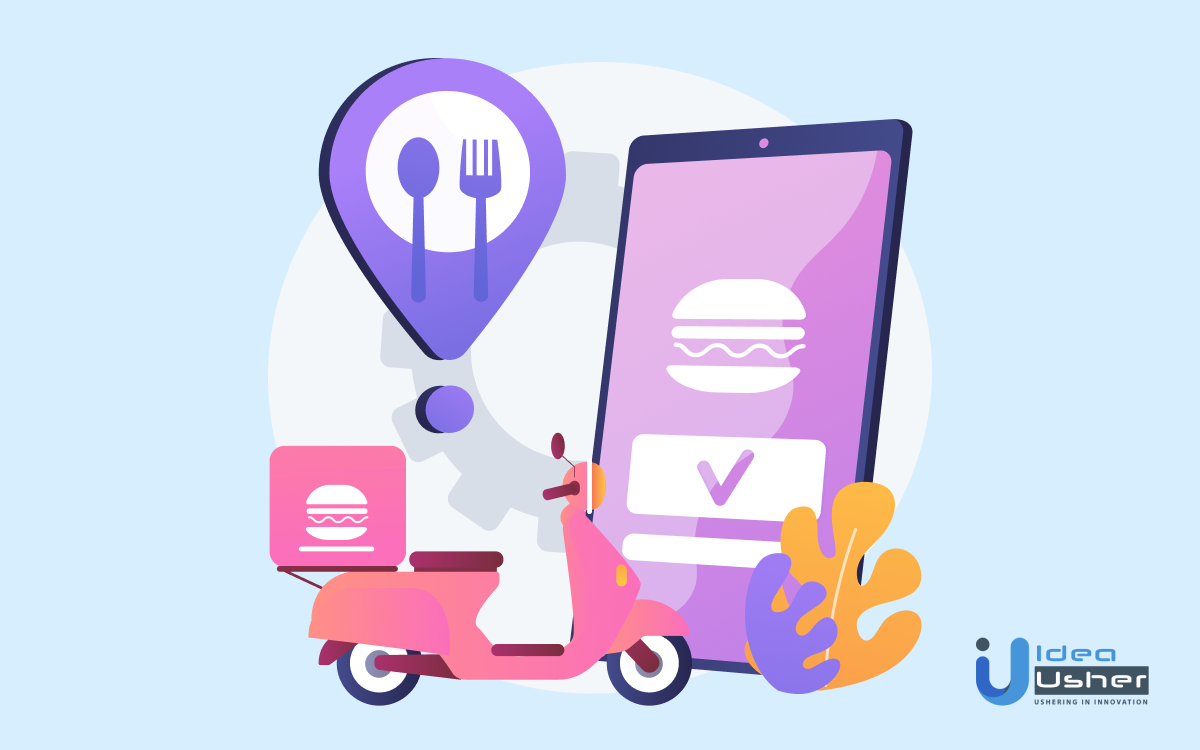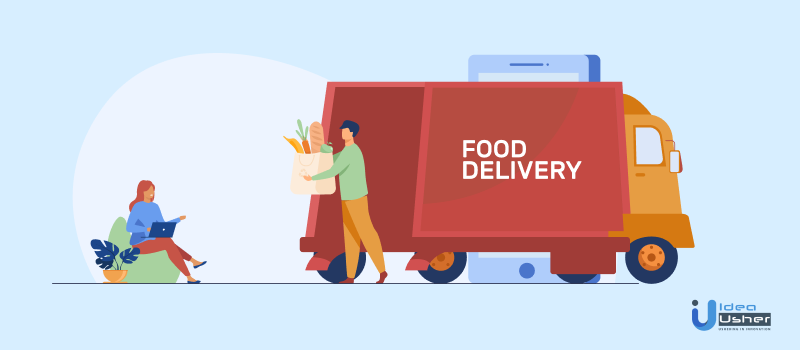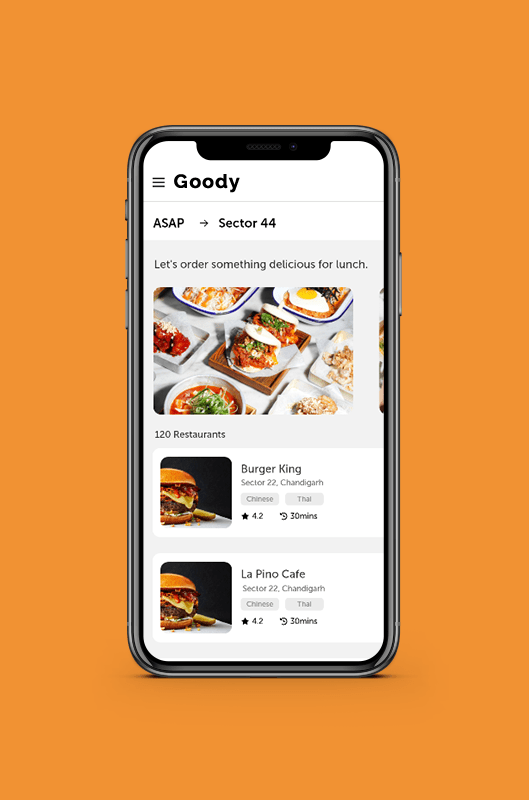The business of buying goods and services and having them delivered to your home or office has been developing for some years, and it has accelerated its expansion during times of crises and epidemics. Most families have become accustomed to receiving ready-to-eat meals delivered to their homes, and in the coming year, we will increasingly order goods at home and prepare them ourselves. It will be ineffective to waste time shopping. This article will give you a brief overview of the necessary features of a food delivery application.
Many people already use taxis to give one other key, documents, and small parcels. With the growth of the walking courier industry, these services will become even more affordable and widespread.
Why are Food Delivery Apps Profitable?
As the digital era dawns, businesses are going digital, making people’s lives easier, faster, and more convenient. People nowadays have so little time for their everyday activities that they seek out immediate answers at reasonable prices right at their doorway.
Also, read: 10 best food delivery apps of London list (2021 edition)
On-demand mobile applications flourish here because of their ease. You can acquire whatever you need with a single swipe on your phone, including taxis, movie tickets, food, hotel reservations, and more. This is why every company is focusing on mobile app development these days.
Do you intend to invest in the creation of an on-demand food-ordering app? But are you unsure if it’s a good investment? Here are some numbers to help you see things clearly:
- In 2015, the total income generated by a mobile app for the restaurant industry was $160 million.
- In 2019, the online meal delivery business generated $7,092 million in revenue. With such a market volume of $5,825 million, Restaurant-to-Consumer Deliveries are the market’s most significant chunk.
- The eServices online food delivery sector Restaurant-to-Consumer delivery is predicted to generate $22,898.2 million in sales in 2023.
Statistics on Online Ordering and Delivery
- Once a week, 60 percent of Americans buy delivery or takeout. (source)
- Since 2014, digital ordering and delivery have grown by 300 percent when compared to dine-in traffic.
- According to recent reports, the size of the global online on-demand food delivery services market is expected to expand by USD 266.05 billion between 2022 and 2027, with a compound annual growth rate (CAGR) of 24.64%.
- Apps for on-demand delivery Instacart, Walmart Grocery, Shipt, and Target recently had a 218 percent, 160 percent, 124 percent, and 98 percent increase in daily downloads, respectively. (source)

The market is growing as the consumer popularity of online meal ordering grows. It’s a good idea to think about mobile app development to increase your return on investment. The market is brimming with possibilities, and now is the time to seize them.
Features of Food Delivery App that Every Restaurant App Should Have

Now that you’ve made the wise decision to create a restaurant meal ordering app, the following step is to decide what features to include.
Accordingly, we’ve put up a list of 15 of the most critical characteristics that any restaurant app should have to be popular with customers.
To create an exceptional app for your food business, you must first understand the fundamental aspects of an on-demand food ordering app. The following are the top 15 features of the food delivery application.
1. On-Demand Food Ordering App Push Notifications
With the rapid growth of online meal ordering, it’s understandable to have many food delivery apps on your phone. Sending push notifications is the best approach to gaining visibility and remaining ahead of your rivals. Accordingly, it assists businesses in keeping in touch with their customers. These messages can be used to send various information, including discounts, special offers, and location-based order drop messages, among other things.
Another thing to keep in mind in your on-demand ordering food app is that your notifications should provide value to customers rather than just be a sales pitch. Attempt to manage push notifications in such a way that they aid in the considerable growth of your business app. Notify prospective consumers about discounts, special deals, and loyalty programs regularly. Accordingly, you can immediately attract a customer’s attention and engage them this way.
2. Providing Contact Information for the Delivery Person
Let’s pretend the customer has made an order and paid for it. You might want to provide the consumer with the delivery person’s contact information. Accordingly, the function allows consumers to contact the delivery person and track their orders.
3. Reward/Discount Programs, Cashback Programs, and Loyalty Programs
Coupons and special offers are the most effective ways to attract new users to your food delivery application. Accordingly, to keep clients interested, you should give generous discounts regularly.
To win brand loyalty, it’s more important to attract potential customers than to raise brand awareness. This is why large corporations place a greater emphasis on their reward points. Accordingly, Starbucks, for instance, saw an 80 percent increase in sales after introducing loyalty programs.
4. Food Delivery GPS Tracking in Real-Time
Customers may track the location of their food using real-time GPS, which is one of the essential features of food delivery apps. The goal of GPS is to provide two-way tracking and operation. Accordingly, it assists in determining the user’s location to deliver the food. Users may simply follow the status and movements of the delivery people once the site has been confirmed.
It is used by the main meal delivery applications to provide the most outstanding client experience. Accordingly, Google Maps, MapKit, and Waze’s Navigation are just a few of the fantastic APIs for this functionality. Uber eats, for instance, uses Google Maps across all platforms.
An interesting fact: Uber Eats became popular for its real-time order tracking.
Also read: How to build a food delivery app like Uber Eats?
5. Simple Payment Methods
Payments play an essential part in any firm, according to the perspective of a business owner. Even though it is the final step in the order placement process, consumers will not try again if they have any minor or significant issues. Accordingly, a consumer must have all of the funding options listed within your on-demand food delivery app for the payment procedure to be highly productive and uncomplicated to use.
You can use any accessible payment gateways or mobile wallet software services, such as Google Wallet, Apple Pay, iOS Paypal account, Mastercard, Credit/Debit Card, Internet Banking, and Cash On Delivery (COD) options. Accordingly, a similar page can also be used to offer promotional or discount code utilization.
6. Search Filters
Customers will appreciate the ease and time savings that a sophisticated search feature with numerous criteria may provide as You have the freedom to search out the eateries you want by downloading a restaurant aggregator/ordering app. Accordingly, users should search for items based on timely delivery, distances, or even menu choices, which vary from place to More is required for an app for a single restaurant or chain.
7. Integrate Social Media
Allowing your users to contribute photographs and reviews of dishes they’ve tried on social media and the app can help you obtain a lot of organic exposure. It’s a terrific approach to getting input and provides a lot of information for your social media team to work with. Accordingly, this will help customers to get attracted to the reviews and will increase sales.
8. Profile Customization and Registration
The user’s profile is essentially a database of information. Past orders, preferences based on order analytics, shipping addresses, saved outlets, payment options, and more could all be included. Accordingly, the customer’s favorite feature of the profile is easy to access to this information.
9. Order History
A list of possible items should indeed be chosen on the courier’s working screen that has not yet been managed to pick up by any of the couriers. All orders should be displayed by default within a 750-meter radius of the courier’s present position. Accordingly, in addition to the set delivery time, the patient’s address and the consumer’s contact information should be included in the list of orders.
10. Messaging within the App
In-app alerts are announcements that appear on the user’s screen while the app is open. Accordingly, it can take the form of pop-ups or colorful interstitials, but they’re all intended to deliver targeted or context-sensitive information.
Accordingly, in a courier app, a messenger is a must-have feature for connecting with customers and clarifying specifics with the administration.
11. Improved Status
The grades inform the courier about the order’s requirements. Accordingly, this means he can go to the restaurants and pick up the order and bring it to the receiver throughout this time.
The courier can change the status of the order at any time. Accordingly, the customer is automatically advised of the change in position in the applications whenever he changes the delivery status.
12. Ratings and Reviews
This option enables your customers to rank and evaluates other restaurants on the app based on their listed food. Therefore, every company values its consumers since they are the lifeblood of the company. Accordingly, any form of feedback or rating is highly beneficial to a company’s understanding of the drawbacks of their on-demand delivery software.
This is a tried-and-true method for businesses to learn how users react to their apps. Accordingly, if your app has a high rating, there’s a good likelihood that many people will prefer to visit it.
13. Assist with Virtual Work
The advancement of AI technology has resulted in the development of virtual assistants. Customers can use messengers or a single phrase to order their favorite products. Using GrubHub as an instance, the app has connected Alexa, Amazon’s digital assistant, to allow customers to repurchase any prior orders. Accordingly, the virtual assistant also provides a rough delivery schedule for the order.
14. Easy Learning Curve for Users
Any food delivery app’s primary purpose is to generate revenue. Accordingly, the shopping cart is, of course, one of the essential tools for making in-app sales. A customer’s online shopping basket is a website where they can submit things for purchase. Accordingly, the majority of consumers choose to order online because the process is quick and easy.
An on-demand food delivery software requires a fantastic user interface (UI) design.
Users should be able to explore and discover what they require efficiently. Accordingly, if the UI takes too long to load, it will harm the user experience. It needs to load all of the components quickly.
15. Personal Favorites
This allows customers to choose their favorite restaurants and dishes. Accordingly, the concept behind a favorites mark is to make it easier for customers to find their favorite foods, making reordering a snap.
Bottom Line
The Uber for X strategy is successful in one area: food delivery. We’ve covered all of the features you’ll need to build a top competitor in the food delivery business in this article. Our experienced app developers will be delighted to assist you in developing a meal delivery app.
For more information, contact us.
Work with Ex-MAANG developers to build next-gen apps schedule your consultation now
FAQs
Why are on-demand meal delivery apps so popular?
Customers can purchase food from various eateries and deliver it to their doorstep without interrupting their workday. Accordingly, customers want convenience and flexibility, and the growth of online meal delivery services is growing.
What are the advantages of using a food delivery app?
1. Increase the number of customers you have.
2. Easy.
3. A wide range of choices is available.
4. There are a variety of payment options.
5. Cost-effective promotions.




















